Parliamentarian - commonly called 'Century White'
©Compiled by Michael Russell OPC for Fordington April 2009 - Last updated May 2013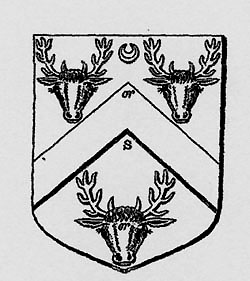
'White' Coat of Arms (14b)

(Main source: See Gen Notes 2 and 14 below) [Surname in records as White; Whitt; Whitte; Whitre; ] John WHITE (1590-1645) a politician and lawyer, was commonly referred to as 'Century White' to distinguish him from other prominent people of the same name. He was descended from a family of wealthy merchants who had been closely identified for many generations with the town of Tenby and his life is featured in the Dictionary of National Biography(1). Unlike the families with which they intermarried, the Whites were of burgess origin, prosperous merchants established in the town of Tenby as early as the thirteenth century. It seems clear that the ancestor of the family was of English extraction who had settled in Tenby where his descendants prospered by trade. That they were among the leading burgesses of that town over a long period is illustrated by the fact that between 1514 and 1658 they filled the office of sheriff of Pembrokeshire thirteen times and between 1420 and 1498 were Mayors of Tenby on no less than 30 occasions.(2,3,4) 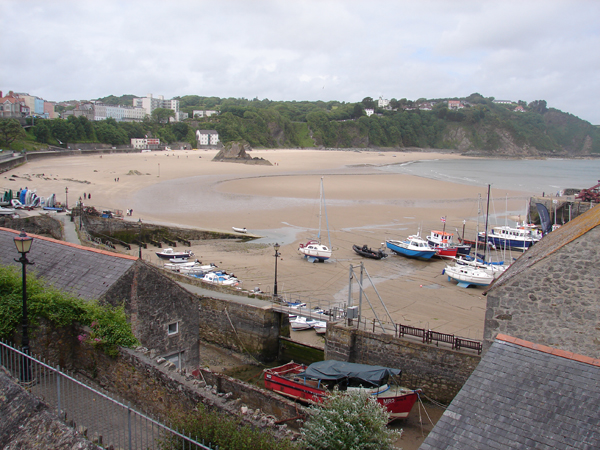
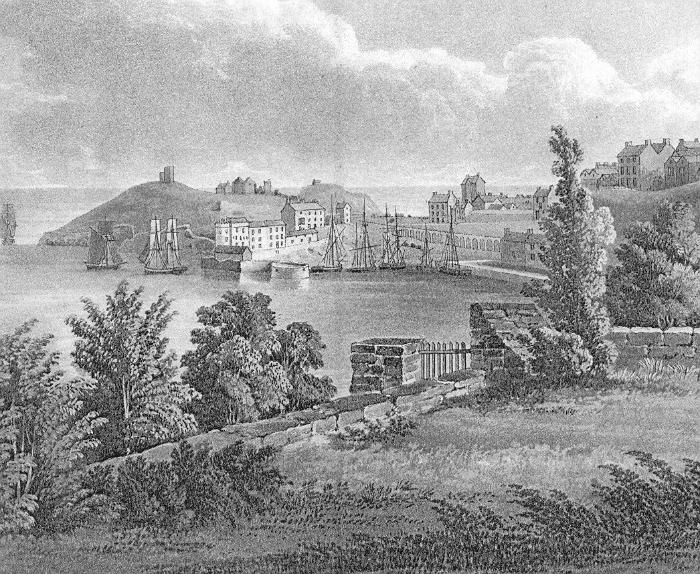
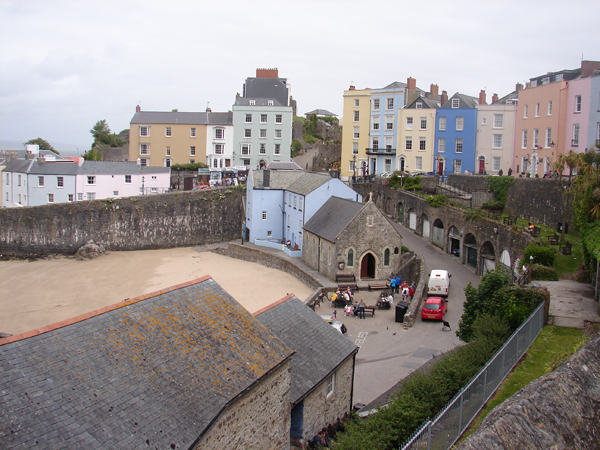 Etching of Tenby Harbour dated 1817 & pictures as it was in July 2013 According to the Visitation of Wales taken by the heralds between 1586 and 1613(14a):- His line of descent is:- 1st generation: John le WITT Esq. alive in 1352, descent was via his son 2nd generation: John le WITT Esq. alive in 1360 descent was via his eldest son 3rd generation: Thomas le WITT Esq. alive in 1390 descent was via his son 4th generation: Jenkyn le WITT Esq alive in 1461 who married Elen the sole heiress of Jenkyn Peacock of Laugharne of St Brides (who inherited lands at Tenby) She had two sons Thomas and James. descent was via her eldest son Thomas. 5th generation: Thomas le WITT Esq who married twice (1st) Joan [Johana] the daughter of Howel ap Jenkins ap Rowland of Kemes, she was buried at St Marys 20th Sep 1451 & (2nd) to Elizabeth (or Isabella) Butler (from whom there was no issue). Descent was via his son John [or Jenkyn] White:- :- Tombs of Thomas WHITE (d1482) & his son John WHITE (d1507) 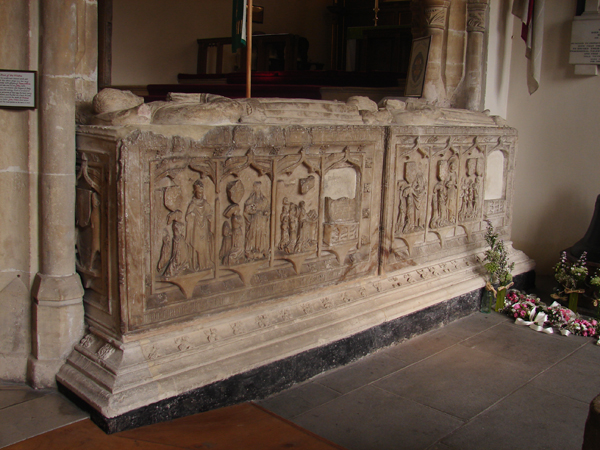 Pictures © Michael Russell OPC Fordington taken 1st July 2013 with permission of the vicar 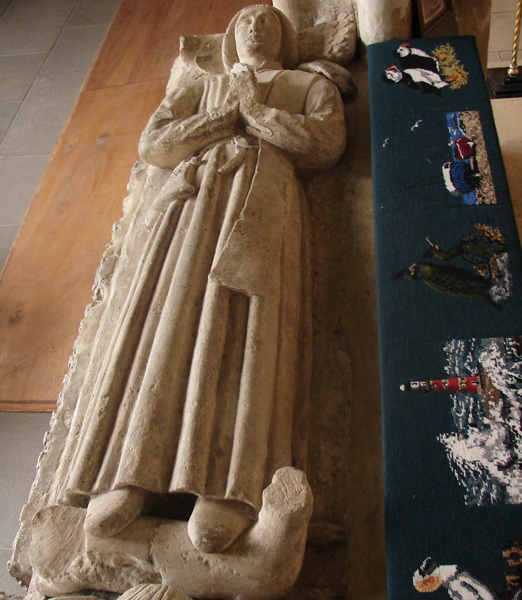
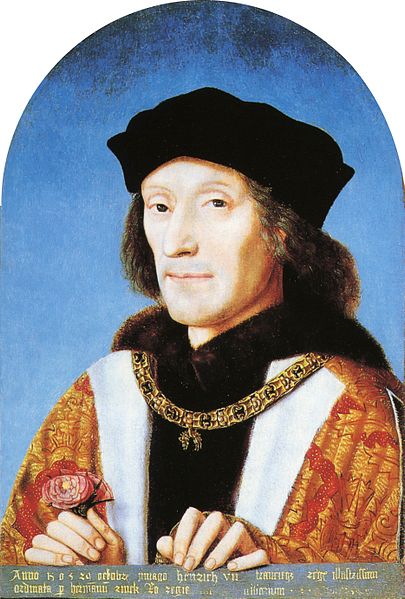 Thomas WHITE Esq. (d. 8 May 1482) was six times mayor of Tenby between 1457 & 1481, and is famous for aiding the Earl of Richmond his mother the Countess of Richmond and Jasper the Earl of Pembroke to escape from Tenby to Brittany after the battle of Tewkesbury in 1471.
The Earl of Richmond who had been born at Pembroke Castle was later to become Henry VII of England (See picture right dated 1505)
Thomas WHITE Esq. (d. 8 May 1482) was six times mayor of Tenby between 1457 & 1481, and is famous for aiding the Earl of Richmond his mother the Countess of Richmond and Jasper the Earl of Pembroke to escape from Tenby to Brittany after the battle of Tewkesbury in 1471.
The Earl of Richmond who had been born at Pembroke Castle was later to become Henry VII of England (See picture right dated 1505) In 1808 a ruined house, close to the northern side of St Mary's church in Tenby, known as "White's House" was traditionally regarded as the home of the family. It was bought by Sir William Paxton who presented it to the Corporation so that it might be demolished "to improve the High Street". This is referred to in Laws book 'Little England Beyond Wales' on page 232 and a sketch of the building is included in Norris's Etchings and reproduced on page 234. The sketches show that it had been a substantial building evidently of medieval workmanship with changes made at later times. It’s thought that the Earl and his party escaped via the cellars under Mayor Thomas White’s house and these tunnels were rediscovered recently under the shop where Boots the chemist now stands(10). The underground cavern runs in one direction towards the harbour. It was from this tunnel that the Earl was said to have been spirited away with his mother and uncle to the harbour and on to one of Thomas White’s boats to Brittany. He returned 14 years later to defeat Richard III at the Battle of Bosworth in 1485 and claim the crown as Henry VII. After Henry had ascended the throne Thomas White's family was rewarded by receiving a grant of lands in the neighbourhood of Tenby. Thomas WHITE's tomb still exists today and is in St Mary's church at Tenby. I took these pictures of it on a recent visit to the church. His first marriage illustrates the in- termarriage that had been going on between the settler families of south Pembrokeshire and the older native stocks of the north. He married Joan daughter of Howel ap Jenkin ap Robert, a landowner of Nanhyfer, senior representative of the widespread family of Gwynfardd Dyfed, whose territorial possessions, together with ability to acquire official appointments, enabled them to dominate north Pembrokeshire for many centuries. Joan died on 20 September 1451, and afterwards Thomas married Isabella Butler but had no issue by her. He died on 8 May 1482, and he and his two wives were buried in St Mary's church, Tenby, where this splendid altar tomb was placed over their remains. Thomas had six sons and four daughters by his 1st wife and descent was via his eldest son John. Closer view of the Tomb of John White (d.1507) 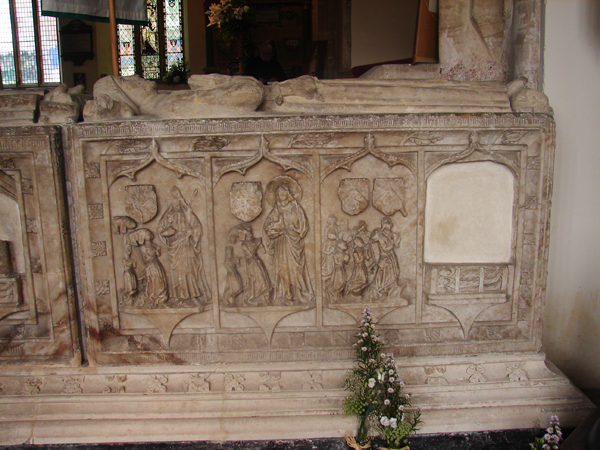 Pictures © Michael Russell OPC Fordington taken 1st July 2013 with permission of the vicar 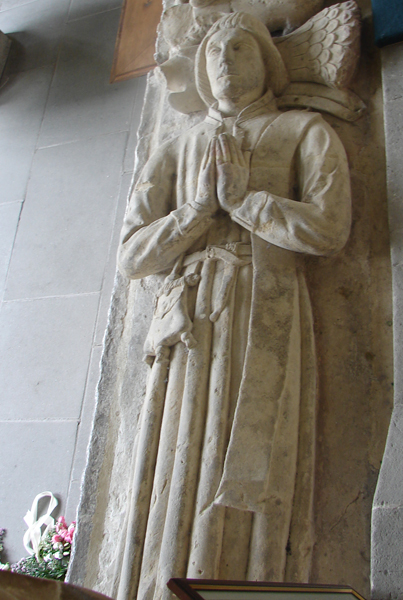
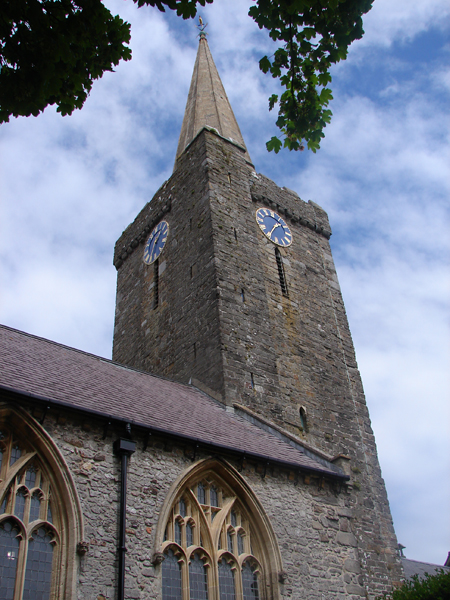 John/Jenkyn WHITE (d.1507) married twice; 1st to Margaret (not Elizabeth as recorded in his pedigree) PHILLIP by whom he had two sons, Thomas (born 1476) and John. Margaret died on 18th Sep 1482. His 2nd wife was Christiana the daughter and co-heiress of John Einion of Henllan and she also bore him 2 sons, James and William. John's fine alter tomb is also in St Mary's church, the inscription confirming that he was a merchant and Mayor of the town. The pedigree confirms his son and heir to be Thomas White.
John/Jenkyn WHITE (d.1507) married twice; 1st to Margaret (not Elizabeth as recorded in his pedigree) PHILLIP by whom he had two sons, Thomas (born 1476) and John. Margaret died on 18th Sep 1482. His 2nd wife was Christiana the daughter and co-heiress of John Einion of Henllan and she also bore him 2 sons, James and William. John's fine alter tomb is also in St Mary's church, the inscription confirming that he was a merchant and Mayor of the town. The pedigree confirms his son and heir to be Thomas White. 7th generation: Neither John/Jenkyn's eldest son Thomas White, or his 2nd eldest son John White by his 1st wife, had any issue. James WHITE referred to as Lord Summerhill, therefore inherited the family estates. James White married Margaret the co-heiress of John Harbett of Laughern and gave issue to their only son Griffith White who was Century White's grandfather 8th generation: Griffith WHITE Esq. of Henllan (now written Hentland) in the County of Pembrokeshire, was a Justice of the Peace and sheriff twice of the County and the first of the White family to settle at Henllan. He married twice first to Mary the daughter of Sir Owen Perrot of Eastington in Rhoscrowther parish by whom he had two daughters. His second marriage probably took place in 1545 (his marriage settlement is dated 15th August that year) and was to his cousin Margaret daughter and co-heiress of Thomas Watkins of Loveton and Henllan. Ref to The Pembrokeshire Historian Pages 63/4 reveals the vast estates inherited and purchased by Griffith White who was a very rich man. Like his forebears he took an active part in public life. he was a Justice of the Peace in 1575 (and before that date) and served as High Sheriff of the County in 1561; 1570 and 1581. Griffith died in March 1589/90 and was buried at Rhoscrowther. Griffith by his second wife Margaret had 11 children but Century White's father was his second son Henry. 9th generation: Henry WHITE Esq. (d.1613) After a number of complicated legal cases involving his siblings Henry White became possessed of Henllan and was living there prior to 1602. In 1603 he was Justice of the Peace for Pembrokeshire and served as High Sheriff in 1592 and 1604. It was Henry White who gave the family pedigree to the Herald Lewes Dwnn on 18th Nov 1591 and paid him 10 shillings for recording it. He married Jane the daughter of Richard(1) FLETCHER of Bangor in Carnarvon and their first child was Griffith White (born circa 1588), the second John or Century White as we know him, the third William and forth Judith. Henry White died in 1613 leaving a will dated 22nd Aug 1613 which was proved on the 16th September that year. After various bequests he leaves property and household goods etc to his wife Jane, a bequest of £200 or £20 a year to his son William (a minor). All the residue of his goods and chattels he left to his dutiful and loving son Griffith White "whome God bless", and appointed him sole executor. There is no mention of Judith in the will as she had received her inheritance as part of her marriage settlement when she married Henry Lort of Stackpool Court probably circa 1609. John appears to have been omitted altogether - see below. John WHITE - known as Century WHITE (1590-1645) was born on 29 June 1590 in the parish of Rhoscrowther in Pembrokeshire Wales and was initially educated at home. He matriculated at Jesus College Oxford together with his elder brother Griffith on 20 Nov 1607. Jesus College was founded in 1571 by Queen Elizabeth I at the request of a Welsh Clergyman called Hugh Prince who was treasurer of St David's Cathedral in Pembrokeshire. The college was intended for the education of future clergymen. The 1571 charter stated that it would be a 'college of learning in the sciences of philosophy, the moral arts, and knowledge of the Hebrew, Greek and Latin languages, with the eventual aim of professing sacred Theology'. Fledgling lawyers were already well catered for, especially at All Souls College and New Inn Hall, Oxford and the Inns of Court in London, whereas there was a clear need for the training of dedicated, learned clergy to promote the Elizabethan church settlement in the parishes of England, Ireland and Wales. White was then aged 17 and probably sent there to train to join the church but was free of the real burden of expectation placed upon his brother Griffith who soon had to leave university.
(Note:- See Gen Note 1 below) The Dictionary of National Biography(1), the account of his life in the Pembrokeshire Historian(2) and his pedigree at the Visitation of London(14b), which was submitted and signed by himself, all show that he married twice:-
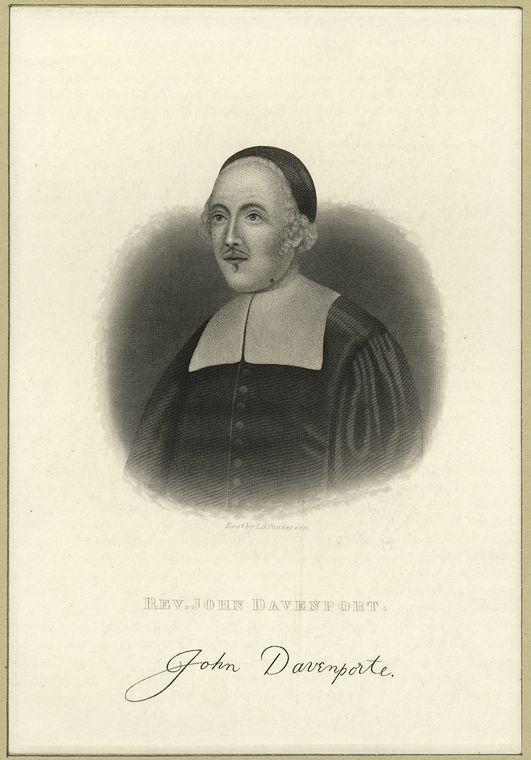
 Marriage of John White to Mary Still at St Stephen's Church Coleman street - 1st September 1631 The Vicar of St Stephen's church was the Rev John DAVENPORT (1597-1670) see picture left. John Davenport had been appointed vicar in 1624 and the following year he became a member of the 'Committe of Feoffees for Impropriations' with 'Century White'. (See 1625: below). Being a close associate of Century White he married them at St Stephen's Church in 1631. Following persecution & censure by the star chamber he resigned from the established church and moved to Holland in 1633. He was superceded as vicar of St Stephen's by another prominent Puritan preacher the Rev John Goodwin. Davenport shared many of the same ideals as 'Century White' and in 1637 he acquired the patent for a colony in Massachusetts and sailed with much of his congregation for Boston. In March 1638 he co-founded the Colony of New Haven. John and Mary White had four sons and five daughters. From the visitation record submitted by White in 1633 we know that the first two of these were his son and heir John White and daughter Mary White. I have not so far been able to locate where they were baptised.(16) 1607-1610: White is said to have been a puritan from his youth and as I speculated above I think these views were formulated during his time at University. 1610: Entered the Middle Temple to study law - and then established a law practice 1620's: Because of persecution by the established church he also believed in the establishment of puritan colonies in New England and and a great supporter of John White the Patriarch's vision of a new godly community. From an early date he invested in a number of puritan colonizing ventures and had an interest in the Virginia Company (1606-1624), the Dorchester Company (1624-1626) and its successor the Massachusetts Bay Company (1629). In 1626 his name is the last to appear on John White the Patriarch's listing of 119 members of the Dorchester Company (1624-1626) and he is credited with having drawn up the companies charter. Century White was no relation of John White the Patriarch, but certainly a kindred spirit. 1625: He and eleven others formed themselves into a committee known as the feoffees for impropriations. A large fund was speedily raised by voluntary contributions for the purposes of buying up impropriate tithes, so as to make a better provision for a preaching ministry.
1629: he acted as counsel for William Coryton when charges were drawn up against him for his conduct in the 1629 session of parliament. 1631: On 3rd May 1641 he together with his colleague from the Middle Temple Edward Bagshaw signed the oath "To live and die for the Protestant religion, the liberties and rights of subjects and the privilege of Parliaments" at the House of Commons. He also married on 1st Sep 1631 to his 2nd wife Mary Style and had 2 of their 8 children by 1633 1640: On 26 Oct 1640 White was returned to parliament for Southwark and remained their MP until his death. When in Nov 1640, it was decided that there should be a grand committee of the house to inquire into the immoralities of the clergy.
1641: With reference to the episcopacy, White advocated a ‘root and branch’ policy of extirpation, and two of his speeches on this subject were published, namely, that delivered in June 1641 on the introduction of the first bill for the exclusion of the bishops, and another concerning the trial of the twelve bishops delivered on 17 Jan 1641/2, on which day he was also appointed a member of the commons committee to hear the bishops’ defence in the House of Lords. He was also occasionally entrusted with the task of licensing publications, and was charged by the church party with being too ready to licence works attacking the church. 1642: As MP for Southwark White was among the delegation sent on 4th February 1642 to thank local women for their petition for church reform, although there was no precedent for a petition from women. On 10th June 1642 Century White offered £100 to the parliamentary war effort. That year he was appointed as lay member of the Westminster Assembly of Divines along with his mentor John White the Patriarch who had been forced to flee from Dorchester and was then living in London. 1643/4: He gave evidence against Laud on two occasions -- first along with Sir Richard Pepys the elder [qv] pn 22 Mar 1643/4, with reference to Laud’s removal of Edward Bagshaw from the readership of the Middle Temple; and secondly on 5 July as to Laud’s attack upon himself when he appeared before him as counsel (Troubles and Trials in Laud’s works) Towards the end of 1643 he published a book called “A looking glass for cowardly Governors”. 1644: He chaired the committee to consider the assembly's proposals on ordination in September 1644 and introduced the bill for introducing the Directory for Public Worship of God to replace the Book of Common Prayer. White was also a member of various committees set up to combat idolatry, including the committee chaired by Sir Robert Harley which drew up the ordinances of 1643 and 1644 for the demolishing of monuments of idolatry and superstition. Whites final activities in the Commons was as a manger and reporter at the conference on the peace propositions on 8th November 1644. Contemporaries describe White as a grave and learned lawyer, an opinion confirmed by his two published speeches. His hostility to the episcopal system was extreme, and after his death his enemies tried to damage his reputation by charging him with conjugal infidelity and open immorality. 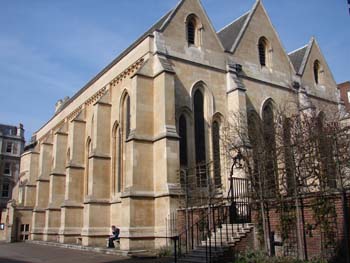 Temple Church - Middle Temple, London He died on 29 Jan 1644/5 and was buried at the Temple Church, at the high altar, on the Middle Temple side, the members of the House of Commons attending his funeral in a body. The marble stone memorial inscription placed over him contained the following verses. His name, life, actions were all White. Sources & Genealogical Notes: (1) There are two versions of the Dictionary of National Biography: The older version (Link to page 58) written by Sidney Lee and quoted as its source in the Genesis of the White Family - referred to Thomas WHITE (d. 1482) etc as one of his ancestors but this has been omitted in the Oxford Dictionary of National Biography, Oxford University Press, published 2004 - by Jacqueline Eales (Link to an on-line transcription of pages 596/9), under ‘White, John (1590–1645)’ The old version actually gives Thomas White's year of death as 1492 which is an error as it should be 1482. Note:- The Dictionary of National Biography supported by the Annals & Antiquities (see 5 below) both say that his father Henry married Jane the daughter of Richard FLETCHER of Bangor in Carnarvon but the Visitation of London in 1633 states his name was Thomas Fletcher? [the visitation was signed by Century White but I think he probably made an error?] The old version of the DNB also states that John first married Janet daughter of John ap Griffith Eynon of Jeffreston Pembrokeshire and gives a ref document Pembr. MS Pedigrees, 1685, penes Henry Owen esq FSA to which I have been unable to get access. It also then states 'By his second wife Winifred daughter of Richard Blackwell of Bushey Herts he had four sons and five daughters'. It then goes on to give the same information regarding his next marriage to Mary as stated above. The reference to his second wife being Winifred flies in the face of John White's own submission to the Heralds at the Visitation of London in 1633 where he clearly states his wife to be Katherin Barfoot and his daughter to be Winifred, so this is another error and I suspect this is why the new version of the Dictionary only refers to his two wives as I have depicted above. To add confusion to chaos The Genesis of the White Family (7 below) goes on after the entry from the old DNB to quote on page 122 yet another source 'A letter from John Holding MA' which repeats a lot of the old DNB information and states after 'he married thirdly Mary Styles of Little Missenden Bucks'. "He had a forth wife Elizabeth Finch of Waterford (Herts) who was mother of Miss White who married Dr Samuel Annesley". If he had nine children that survived him six of these at least would need to be born after the 1633 visitation and that does not seem to leave room for a 4th marriage. I have not been able to locate this marriage and have chosen to stick with the more substatiated history recorded in the new Dictionary of National Biography but leave these references in case more information comes to light as more records are indexed over the next few years.] (2) Welsh Journals On Line - The Pembrokeshire Historian Issue 5 1974 : licenced for reuse : White of Henllan eg from page 58 - 78: Link to page 59 (3) Listing of the High Sheriffs of Pembrokeshire This listing does not start until 1540. According to the Pembrokeshire Historian (2 above) members of the White family were sheriff on 7 occasions between 1415 and 1568. This listing shows that they were also Sheriff :- Griffith (1561 included in the 7) 1570; 1581; Henry 1592; 1604; Griffith 1627; Henry 1658. (4) Mayors of Tenby from 1402 (5) The Oxford Alumni and the Visitation of London 1633-35 which was submitted and signed by Century White (6) Annals & Antiquities of the Counties & County Families of Wales Volume 2 by Thomas Nicholas. Page 911 County Families of Pembrokeshire (7) The Genesis of the WHITE Family compiled by Emma Siggins White assisted by Martha Humphreys Maltby printed Kansas City Tierman-Dart Printing Co and published in 1920. Within which publication John WHITE (1590-1644) See page 121 (8) Royal Commission of Ancient & Historical Monuments of Wales St Marys Tenby Sources: CADW listed buildings database; T.J. Hughes, Wales's Best One Hundred Churches, 2006. RCAHMW, 13th November 2007. Site description states in referring to various tombs within the church to "and others of Thomas White (d 1482) and his son John (d c1507), both finely carved figures in contemporary dress, and an effigy of a cadaver of a priest." (10) Article in Wales on-line dated 15th Feb 2012 'Medieval tunnels found under Tenby linking Henry VII to current Boots site'. (11) Chalmers Biographical Dictionary says he was summer reader 17th year of the reign of King Charles I (i.e.1641) and at length a bencher of that society. (12) Pemb. M.S.Ped 1685 penes Henry Owen Esq FSA (13) Rose-Troupe in her book 'John White The Founder of Massachusetts' as an investor in the Dorchester Company; (14) (a). Visitation of Wales 1586-1613 page 129 & (b). The Visitation of London 1633 Page 346 (15) Chambers General Biological Dictionary pages 403/4 (16) Although a lot of records have been digitized this year (May 2013) relating to London this is by no means comprehensive and there is nothing of import for Hertfordshire where some historians seem to suggest the family lived. I have not therefore been able to give any credible line of descent but this may be possible as more records become available. (17) British History on Line Acts and Ordinances of the Interregnun 1642-1660 June 1643 Assembly of Learned and Godly divines |